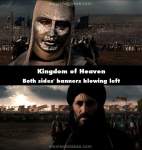
Other mistake: At Kerak, as the 2 armies are facing off, the wind is blowing the banners of Saladin's army hard to the left, but as the view switches to Baldwin's army, facing the opposite direction, their banners are also blowing left. (01:33:00 - 01:33:50)
Continuity mistake: As Orlando Bloom is talking to his bald comrade walking through lined up guards, after they realise the enemy has arrived, neither is wearing armour. As they stroll through the arch, you see that both are now wearing armour. (02:18:05)
Revealing mistake: Director's Cut Only: After Godfrey's party has been attacked in the woods, a surviving noble is executed by the sergeant. We see his axe strike from behind, then the shot cuts to show the face of the noble as the sergeant pulls the axe out and off-camera. As the noble slumps forwards, the axe reappears in frame from below and it can be seen that the axe has no forward point, allowing it to be placed against the head of the actor playing the noble as if embedded. (00:29:25)
Factual error: Balian is depicted in the start of the film to be from France. He was actually a Poulain, a Frank having been born in Outremer.
Factual error: In the beginning of the movie during the burial scene, it looks like a modern community in the background.
Suggested correction: You don't see a "modern" community in the background. You see a few houses, but nothing to indicate anything that it's not part of that time period.
Continuity mistake: Just before the end of the movie in a scene where Balian and Sibylla ride on horses, they briefly stop next to a concrete cross and we can see village/houses in the far background (middle of the screen). In the next scene we can see all these houses being removed/replaced with woods. (03:00:10)
Factual error: When Balian arrives in Ibelin, on the wall inside the manor house, he's watching the painting depicting the Dance of Death, with the writing 'quod sumus hoc eritis'. However, the earliest known Dance of Death (Danse Macabre) paintings are from the first half of the 15th century. This motif developed during the late medieval period, inspired by the memory of the Black Death.





